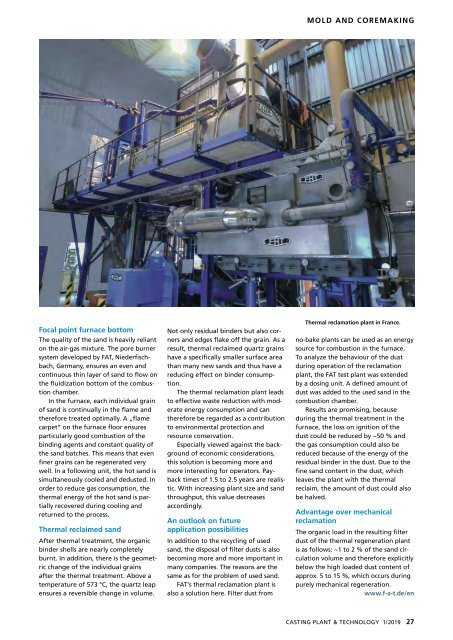CPT International 01/2019
You also want an ePaper? Increase the reach of your titles
YUMPU automatically turns print PDFs into web optimized ePapers that Google loves.
MOLD AND COREMAKING<br />
Focal point furnace bottom<br />
The quality of the sand is heavily reliant<br />
on the air-gas mixture. The pore burner<br />
system developed by FAT, Niederfischbach,<br />
Germany, ensures an even and<br />
continuous thin layer of sand to flow on<br />
the fluidization bottom of the combustion<br />
chamber.<br />
In the furnace, each individual grain<br />
of sand is continually in the flame and<br />
therefore treated optimally. A „flame<br />
carpet“ on the furnace floor ensures<br />
particularly good combustion of the<br />
binding agents and constant quality of<br />
the sand batches. This means that even<br />
finer grains can be regenerated very<br />
well. In a following unit, the hot sand is<br />
simultaneously cooled and dedusted. In<br />
order to reduce gas consumption, the<br />
thermal energy of the hot sand is partially<br />
recovered during cooling and<br />
returned to the process.<br />
Thermal reclaimed sand<br />
After thermal treatment, the organic<br />
binder shells are nearly completely<br />
burnt. In addition, there is the geometric<br />
change of the individual grains<br />
after the thermal treatment. Above a<br />
temperature of 573 °C, the quartz leap<br />
ensures a reversible change in volume.<br />
Not only residual binders but also corners<br />
and edges flake off the grain. As a<br />
result, thermal reclaimed quartz grains<br />
have a specifically smaller surface area<br />
than many new sands and thus have a<br />
reducing effect on binder consumption.<br />
The thermal reclamation plant leads<br />
to effective waste reduction with moderate<br />
energy consumption and can<br />
therefore be regarded as a contribution<br />
to environmental protection and<br />
resource conservation.<br />
Especially viewed against the background<br />
of economic considerations,<br />
this solution is becoming more and<br />
more interesting for operators. Payback<br />
times of 1.5 to 2.5 years are realistic.<br />
With increasing plant size and sand<br />
throughput, this value decreases<br />
accordingly.<br />
An outlook on future<br />
application possibilities<br />
In addition to the recycling of used<br />
sand, the disposal of filter dusts is also<br />
becoming more and more important in<br />
many companies. The reasons are the<br />
same as for the problem of used sand.<br />
FAT‘s thermal reclamation plant is<br />
also a solution here. Filter dust from<br />
Thermal reclamation plant in France.<br />
no-bake plants can be used as an energy<br />
source for combustion in the furnace.<br />
To analyze the behaviour of the dust<br />
during operation of the reclamation<br />
plant, the FAT test plant was extended<br />
by a dosing unit. A defined amount of<br />
dust was added to the used sand in the<br />
combustion chamber.<br />
Results are promising, because<br />
during the thermal treatment in the<br />
furnace, the loss on ignition of the<br />
dust could be reduced by ~50 % and<br />
the gas consumption could also be<br />
reduced because of the energy of the<br />
residual binder in the dust. Due to the<br />
fine sand content in the dust, which<br />
leaves the plant with the thermal<br />
reclaim, the amount of dust could also<br />
be halved.<br />
Advantage over mechanical<br />
reclamation<br />
The organic load in the resulting filter<br />
dust of the thermal regeneration plant<br />
is as follows: ~1 to 2 % of the sand circulation<br />
volume and therefore explicitly<br />
below the high loaded dust content of<br />
approx. 5 to 15 %, which occurs during<br />
purely mechanical regeneration.<br />
www.f-a-t.de/en<br />
CASTING PLANT & TECHNOLOGY 1/2<strong>01</strong>9 27

















